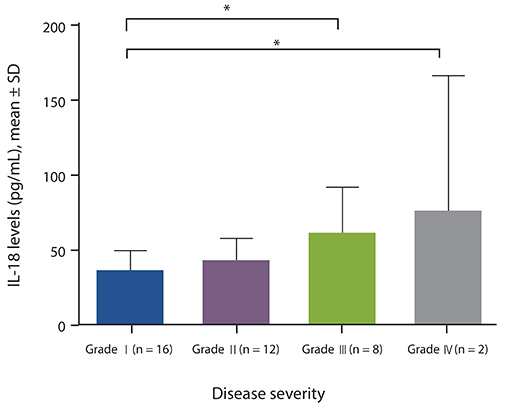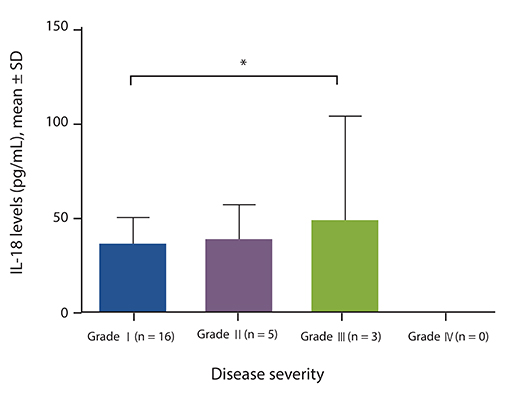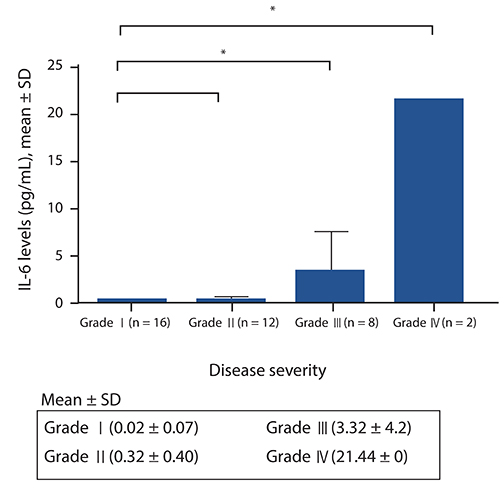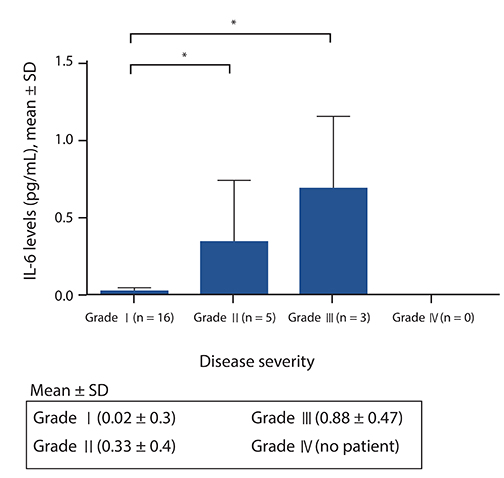Asia Pac Allergy.
2014 Oct;4(4):206-211. 10.5415/apallergy.2014.4.4.206.
Study of serum interleukin (IL) 18 and IL-6 levels in relation with the clinical disease severity in chronic idiopathic urticaria patients of Kashmir (North India)
- Affiliations
-
- 1Department of Immunology & Molecular Medicine, Sher-I-Kashmir Institute of Medical Sciences (SKIMS), Soura, Srinagar 190011, India. roohi_wani@yahoo.com
- 2Department of Clinical Biochemistry, University of Kashmir, Hazratbal, Srinagar 190006, India.
- 3Department of Advanced Centre for Human Genetics, Sher-I-Kashmir Institute of Medical Sciences (SKIMS), Soura, Srinagar 190011, India.
- KMID: 2397101
- DOI: http://doi.org/10.5415/apallergy.2014.4.4.206
Abstract
- BACKGROUND
Chronic urticaria is termed as idiopathic if there is an absence of any identifiable causes of mast cell and basophil degranulation. Various cytokines have been found to be involved in inflammatory processes associated with chronic idiopathic urticaria, including interleukin (IL) 18 and IL-6.
OBJECTIVE
To evaluate any possible correlation of IL-18 and IL-6 cytokines with the clinical disease severity in chronic idiopathic urticaria (CIU).
METHODS
IL-18 and IL-6 levels of CIU patients (n = 62) and healthy controls (n = 27) were assessed by commercially available enzyme linked immunosorbent assay kits following the manufacturer's protocols.
RESULTS
Serum IL-18 concentration (mean ± standard deviation [SD], 62.95 ± 36.09 pg/mL) in CIU patients and in healthy controls (54.35 ± 18.45 pg/mL) showed no statistical significance (p > 0.05). No statistically significant difference (p > 0.05) was observed between autologous serum skin test (ASST) positive and ASST negative patients with regard to the serum IL-18 levels either. Similarly, serum IL-6 concentration (0.82 ± 4.6 pg/mL) in CIU patients and in healthy controls (0.12 ± 1.7 pg/mL), showed no statistical significance (p > 0.05). Also, comparison between positive and ASST negative patients with regard to the serum IL-6 levels was statistically nonsignificant (p > 0.05). However, statistical significance was found both in IL-18 and IL-6 concentrations in certain grades with regard to the clinical disease severity of urticaria.
CONCLUSION
There is no significant association as such found between IL-18 and IL-6 levels with CIU, however, these cytokines may help in predicting the clinical disease severity in CIU. Hence, these cytokines may indicate a potential role as a biomarker to assess the disease severity in CIU.
Keyword
MeSH Terms
Figure
Cited by 1 articles
-
In the memory of Professor Felicidad Cua-Lim
Yoon-Seok Chang
Asia Pac Allergy. 2014;4(4):185-186. doi: 10.5415/apallergy.2014.4.4.185.
Reference
-
1. Fauci AS, Braunwald E, Kasper DL, Hauser SL, Longo DL, Jameson JL, Loscalzo J. Chapter 311. Harrison's principles of internal medicine. 17th ed. New York: McGraw-Hill Medical;2008. p. 2061–2074.2. Ring J, Brockow K, Ollert M, Engst R. Antihistamines in urticaria. Clin Exp Allergy. 1999; 29:Suppl 1. 31–37.
Article3. Kaplan AP, Greaves M. Pathogenesis of chronic urticaria. Clin Exp Allergy. 2009; 39:777–787.
Article4. Sabroe RA, Grattan CE, Francis DM, Barr RM, Kobza Black A, Greaves MW. The autologous serum skin test: a screening test for autoantibodies in chronic idiopathic urticaria. Br J Dermatol. 1999; 140:446–452.
Article5. Grattan CE. The urticaria spectrum: recognition of clinical patterns can help management. Clin Exp Dermatol. 2004; 29:217–221.
Article6. Nakanishi K, Yoshimoto T, Tsutsui H, Okamura H. Interleukin-18 regulates both Th1 and Th2 responses. Annu Rev Immunol. 2001; 19:423–474.
Article7. Izakovicova Holla L. Interleukin-18 in asthma and other allergies. Clin Exp Allergy. 2003; 33:1023–1025.
Article8. Gabay C. Interleukin-6 and chronic inflammation. Arthritis Res Ther. 2006; 8:Suppl 2. S3.9. Sehgal PB. Interleukin-6: molecular pathophysiology. J Invest Dermatol. 1990; 94:6 Suppl. 2S–6S.
Article10. Kasperska-Zajac A, Brzoza Z, Rogala B. Plasma concentration of interleukin 6 (IL-6), and its relationship with circulating concentration of dehydroepiandrosterone sulfate (DHEA-S) in patients with chronic idiopathic urticaria. Cytokine. 2007; 39:142–146.
Article11. Lin RY, Trivino MR, Curry A, Pesola GR, Knight RJ, Lee HS, Bakalchuk L, Tenenbaum C, Westfal RE. Interleukin 6 and C-reactive protein levels in patients with acute allergic reactions: an emergency department-based study. Ann Allergy Asthma Immunol. 2001; 87:412–416.
Article12. Papanicolaou DA, Wilder RL, Manolagas SC, Chrousos GP. The pathophysiologic roles of interleukin-6 in human disease. Ann Intern Med. 1998; 128:127–137.
Article13. Tedeschi A, Lorini M, Suli C, Asero R. Serum interleukin-18 in patients with chronic ordinary urticaria: association with disease activity. Clin Exp Dermatol. 2007; 32:568–570.
Article14. Ibrahim SA, Khalifa NA. Interleukin-18 correlates with disease severity in chronic autoimmune urticaria. Egypt Dermatol Online J. 2009; 5:1.15. Kurt E, Aktas A, Aksu K, Keren M, Dokumacioglu A, Goss CH, Alatas O. Autologous serum skin test response in chronic spontaneous urticaria and respiratory diseases and its relationship with serum interleukin-18 level. Arch Dermatol Res. 2011; 303:643–649.
Article16. Nettis E, Dambra P, Loria MP, Cenci L, Vena GA, Ferrannini A, Tursi A. Mast-cell phenotype in urticaria. Allergy. 2001; 56:915.
Article17. Seder RA, Paul WE, Ben-Sasson SZ, LeGros GS, Kagey-Sobotka A, Finkelman FD, Pierce JH, Plaut M. Production of interleukin-4 and other cytokines following stimulation of mast cell lines and in vivo mast cells/basophils. Int Arch Allergy Appl Immunol. 1991; 94:137–140.
Article18. Fujii K, Konishi K, Kanno Y, Ohgou N. Acute urticaria with elevated circulating interleukin-6 is resistant to anti-histamine treatment. J Dermatol. 2001; 28:248–250.
Article
- Full Text Links
- Actions
-
Cited
- CITED
-
- Close
- Share
- Similar articles
-
- Serum Interleukin-8 Levels in Leprosy Patients
- Serum interleukin-6 in Kawasaki disease
- Prognostic Significance of IL-10 in Childhood Chronic Immune Thrombocytopenic Purpura
- Serum Anti-Acetylcholine Receptor Antibody, Interleukin-2 and Soluble Interleukin-2 Receptor Level in Myasthenia Gvavis
- Serum Tumor Necrosis Factor,Interleukin-1β and Interleukin-6 Levels in Behçet's Disease





